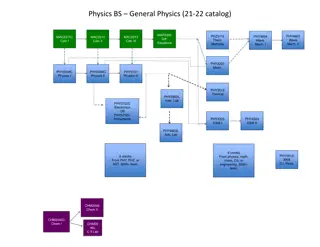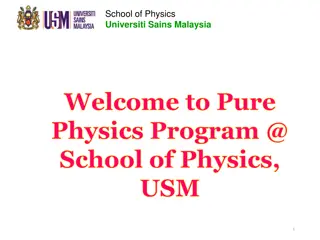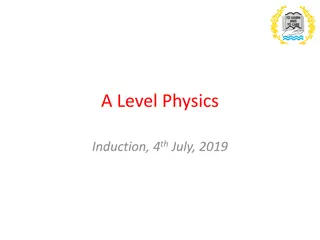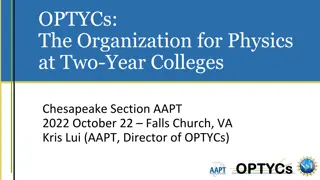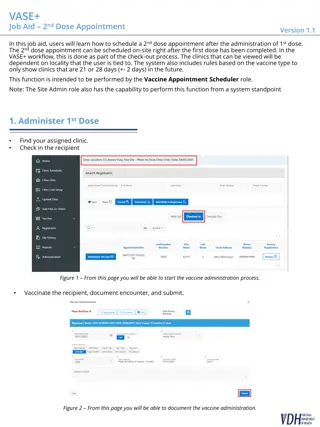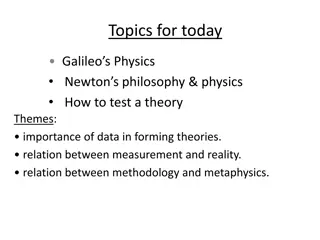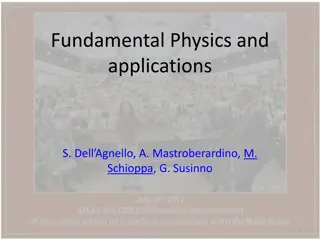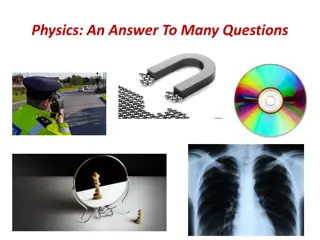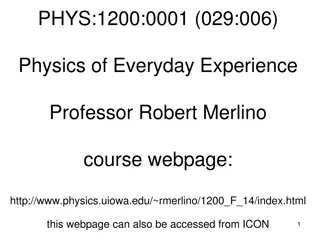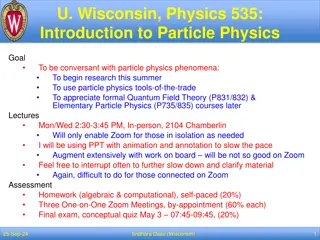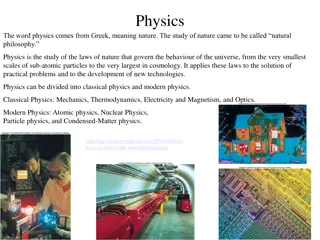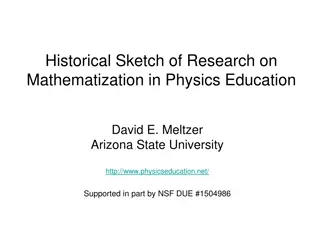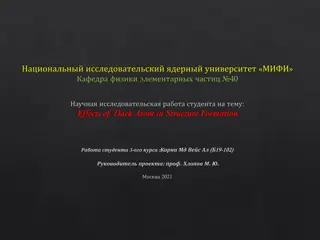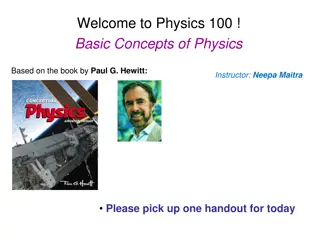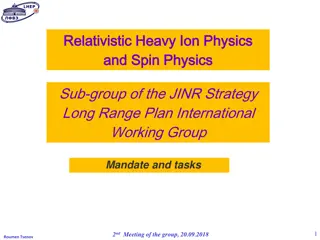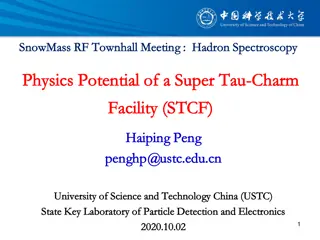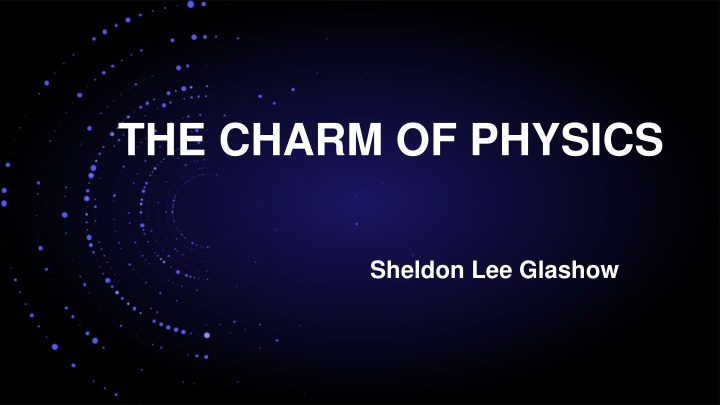
Celebrating Physics: A Journey from Autobiography to Discovery
Join Sheldon Lee Glashow on a historical and autobiographical journey in the realm of physics, from the pivotal discovery of the J particle to the exploration of weak and electromagnetic interactions. Delve into the challenges and aspirations of a young physicist aiming for a unified theory of these interactions, and the exciting journey that unfolds as he ventures through Europe in pursuit of knowledge and collaboration.
Download Presentation

Please find below an Image/Link to download the presentation.
The content on the website is provided AS IS for your information and personal use only. It may not be sold, licensed, or shared on other websites without obtaining consent from the author. If you encounter any issues during the download, it is possible that the publisher has removed the file from their server.
You are allowed to download the files provided on this website for personal or commercial use, subject to the condition that they are used lawfully. All files are the property of their respective owners.
The content on the website is provided AS IS for your information and personal use only. It may not be sold, licensed, or shared on other websites without obtaining consent from the author.
E N D
Presentation Transcript
THE CHARM OF PHYSICS Sheldon Lee Glashow
What a joy it is for me to return to China to celebrate the jubilee of Sam Ting's pivotal discovery of the J particle. My talk will be far more autobiographical and historical than technical. For want of time, I shall focus on the period starting in 1954, when I graduated from Cornell University as a physics major, and ending in 1976, when charmed particles were decisively discovered at SLAC.
After a year or so of graduate study at Harvard, I joined a group of students who were committed to the study of elementary particle theory. We approached Julian Schwinger, a founder of quantum electrodynamics who, at the time, was the senior particle theorist at Harvard. All of the dozen-or-so of us hoped to become his thesis students, and so we all did! After a frustrating attempt to meet with us separately, Schwinger had us all line up in his office. He then spent several hours assigning each of us a different thesis subject.
It was a remarkable performance. I was the last in line, at which point Schwinger had run out of well-defined thesis problems. Instead, he explained to me that weak and electromagnetic interactions share two remarkable features. Both are vectorial, and both display aspects of universality. Schwinger suggested that I create a unified theory of the two interactions, that I seek an electroweak synthesis. How I was to do this he did not say, aside from slyly hinting at the Yang-Mills gauge theory.
By the summer of 1958, I had not met Schwinger's challenge, but I had convinced myself that both weak and electromagnetic interactions might be described by a badly broken gauge theory. More urgently, I had convinced Schwinger that I deserved my PhD degree. I had won a two-year NSF postdoctoral fellowship and hoped to spend it partly in Moscow at the invitation of the recent Russian Nobel Laureate Igor Tamm. With no Soviet visa in hand, I wrote to Niels Bohr, asking whether I might visit his institute in Copenhagen while awaiting my Soviet visa.
Upon his immediate and enthusiastic agreement, I boarded the SS Ile de France, along with my friend, Jack Schnepps, so as to begin our European junkets in luxury. The crossing was memorable, but the great ship would soon be sold for scrap. After we spent some days touring London and Paris in Jack's new car, he drove South to Padova to work with Milla Baldo- Ceolin's emulsion group in Padova, while I took a painfully slow train North to Copenhagen.
By the time our fellowships ran out, Jack had met and married his true love, Lucia, and I had written the paper which would earn my share of the 1979 Nobel Prize. Thankfully, my Soviet visa never did appear. As a result, I found the SU(2) U(1) structure of the electroweak model in the Spring of 1960, while working at Bohr s famous Institute for Teoretisk Fysik at Blegsdamvej 19. After a brief digression, I will explain why it took almost two decades for the electroweak theory to emerge from my model and for it to gain universal acceptance.
Augusto Gamba, Bob Marshak, and Susumo Okubo, in 1959, were the first to propose the attractive notion of lepton-hadron symmetry. Following a model suggested earlier by Sakata, they regarded three fermions as the building blocks of all hadrons: protons, neutrons and lambda hyperons. Similarly, there were just known leptons: neutrinos, electrons, and muons.
Lepton-hadron symmetry was a fascinating notion, but its original version was soon falsified and forgotten: by the discovery of the second neutrino in 1962, and soon afterward, by the invention of fractionally charged hadron constituents, first by George Zweig and Andre Petermann, but far more saliently, by Murray Gell- Mann's three flavors of quarks. Thus, in early 1964 there were two weak doublets of leptons, one weak doublet of quarks, and no trace of lepton-quark symmetry.
Later that very year, I found myself on sabbatical in Copenhagen with my old pal James Bjorken. We realized that the neat notion of lepton-hadron symmetry could be revived imply by adding one more quark flavor to Murray's three. We called the new quark flavor charm and the fourth quark charmed. Thereupon, we had two weak doublets of quarks, just as there were two weak doublets of leptons. Quark-lepton symmetry!
Today, there are three doublets of each, with lepton-quark symmetry still reigning supreme. The third family of fermions would be discovered, piece-wise, over the quarter century from 1976 to 2000.
1964 was truly a banner year for basic physics! Aside from the invention of quarks, whether with or without charm, Oscar Greenberg devised what became the critical notion of quark color. Samios and Palmer spotted the first triply strange Omega-minus baryon, thereby confirming Gell-Mann's so-called eight-fold way. And Cronin & Fitch, et al. discovered CP violation. And Penzias & Wilson stumbled on the cosmic background radiation.
All these discoveries took place in 1964, as did the invention of spontaneously-broken non-Abelian gauge theories by Peter Higgs and his colleagues. And to top off the year, Abdus Salam managed to rediscover my SU(2) U(1) model in 1964, after I had more-or-less abandoned electroweak thoughts because my model faced four seemingly intractable problems. Much to my surprise and delight, all of them would be solved within just a few years.
Listen: Problem I. How could W and Z, the massive mediators of weak interactions, acquire their masses while leaving the photon massless? My friend, colleague, and erstwhile collaborator, Steven Weinberg, brilliantly solved this problem in 1967 by subjecting the electroweak gauge group to spontaneous symmetry breaking, thereby initiating the long search for the Higgs boson. Salam, as was his wont, published the very same solution, but one year afterward.
Problem II. How could an electroweak model of leptons be extended to describe the weak interactions of hadrons? In 1970, John Iliopoulos, Luciano Maiani and I showed how this can be done with quark-lepton symmetry and the so-called GIM mechanism. Thereby, charm earned its name as a device to avert evil, the evil being the unobserved strangeness-changing neutral currents of a charmless model. With GIM, the neutral currents of the electroweak model become innocuous. They conserve strangeness.
Problem III. Can the spontaneously-broken electroweak gauge model be shown to be mathematically consistent? Gerard't Hooft announced in 1971 that he had proven Steve's electroweak model to be renormalizable. He and his mentor, Tini Veltman, would share the 1999 Nobel Prize for this work. In 1972, Claude Bouchiat, John Iliopoulos, and Phillipe Meyer showed that the electroweak model is free of Adler anomalies, provided that lepton-quark symmetry be maintained. The electoweak model makes mathematical sense.
Probem IV. Could the electroweak model describe observed CP violation without invoking additional spinless fields. With only the two known families of fermions, it could not do so. In 1973, Kobayashi and Maskawa showed how the electroweak model could easily and naturally violate CP, if and only if there exist more than four quark flavors.
Soon after the last electroweak obstacle was overcome, on 19 July 1973, the French physicist, Paul Musset, announced that his group at CERN's Gargamelle detector had won the race to detect weak neutral-current interactions, the signal prediction of the electroweak model.
With this discovery, what had been a mere model suddenly became a genuine predictive theory. And, during that remarkably productive year, theorists determined what is likely to be the true nature of the strong nuclear force: Quantum chromodynamics (or QCD) was proposed by Gell-Mann, Fritzsch, and Leutwyler. The theory was shown to be asymptotically free by Gross, Politzer, and Wilczek. The quaintly named Standard Theory of Elementary Particle Physics was born in 1973, when QCD was adjoined to the electroweak theory.
But where oh where can my charmed quarks be? Late in April, 1974, the Fourth Conference on Experimental Meson Spectroscopy met in Boston. In my talk "Charm: an Invention Awaits Discovery," I wagered that charmed particles would be discovered prior to the next such conference. Should they not be found, I promised to eat my hat. Just two months later, high-energy physicists worldwide gathered in London for the 17th of our so-called "Rochester Meetings."
As they celebrated the discovery of neutral currents, John Iliopoulos assured them that the next Rochester meeting would be dominated by the discovery of charmed particles. He staked several cases of fine wine on his claim.
In 1977, each of the two conferences would meet again. The 18th Rochester Conference met in Tbilisi, Georgia. As John foresaw, the meeting focused on the newly discovered charmed mesons. John had won his bet, but he collected no wine. Meanwhile, at the Fifth Meson Spectroscopy Conference, again held in Boston, my friend Roy Weinstein saw to it that each attendee was offered a tiny but tasty candy hat to eat.
Meanwhile, between bets placed and bets won, something had happened that almost no one had foreseen. Early Monday morning on 11 November, 1974, I was awakened by a phone call from my friend, Sam Ting. He asked me to come his MIT office as soon as possible. After I hurriedly dressed, had a quick coffee and took a short drive to MIT, I entered the office where Sam Ting and his long-term collaborator, the late and lamented Ulrich Becker, were impatiently waiting for me.
They showed me their amazing data, and a big bump it was! Could it be a vector meson, like the rho or omega, and be so narrow, or was it something quite different? After discussing the possibilities, I hopped in my car and drove to Harvard, where my colleagues, Alvaro de Rujula and Howard Georgi, excitedly regaled me about the Californian side of the story.
It took but a few days for experimenters at the Frascati laboratory to confirm the BNL-SLAC discovery, and for Alvaro and me to compose and submit our paper, "Is Bound Charm Found?" Sam called his discovery the J particle because Ting in Mandarin resembles the letter J. The SLAC group designated their particle by the Greek capital letter Psi because it resembles a typical reconstructed event. Both groups would soon agree that they had found the same particle, for which they accepted the dual name J/Psi.
The July 5 issue of Physical Review Letters included seven responses to the discovery, but only two of them were correct. One was by Tom Appelquist and David Politzer. Well before November, they realized but did not publish, that those bound states of a charmed quark with its antiquark lying below charm threshold would be exceptionally narrow due to asymptotic freedom of the strong nuclear force, Alvaro suggested to them that such systems be called charmonium. His term made it to the dictionary. The other correct paper was "Is Bound Charm Found.
Among the five false papers, one was written by my beloved mentor, Julian Schwinger.
Over the next few months, theorists at Harvard and Cornell had a lot of fun estimating the masses of the several charmonium states. The Harvard group consisted of Appelquist, De Rujula, Georgi, and Politzer, the Cornell group of Eichten, Gottfried, Kinoshita, Lane and Yan.
Over the next few years, experimenters worked hard to confirm the predictions by detecting and measuring the masses, spins, and transitions among the eight sub-threshold charmonium states. Later on, they would do the same for 14 relatively narrow states of bottomonium (the fifth quark analog to charmonium).
Other experimenters were searching for charmed particles, those containing just one charmed quark or antiquark. Alvaro, Howard, and I, in our 1985 paper "Hadron Masses in a Gauge Theory," included predictions of the masses of various of the then not-yet- discovered charmed mesons and baryons. The first claim to have detected charmed particles was made in 1975 by Palmer and Samios at Brookhaven, again with a bubble-chamber event.
It seemed to show a cascade decay process in which one charmed baryon decays into another charmed baryon, which itself decays. The measured masses of both of the charmed baryons were in excellent agreement with our predictions. Because it was only one event, the claim was not widely accepted. Nick kindly sent me a framed photo of the event, which hung over my office desk for many years.
To this day, I believe that Samios and Palmer had been the first to detect charmed particles, but the physics world was not convinced.
The SLAC electron-positron collider, operating well above charm threshold, was certainly producing charmed particles copiously. Why were they not being detected? I recall attending a conference in Wisconsin which was largely dedicated to this question.
On the flight home, I met my old friend Gerson Goldhaber, who had been struggling unsuccessfully to find charmed mesons. I think I convinced him to try a bit harder. Just a couple weeks later, on 3 May, 1976, Gerson and Francois Pierre succeeded. They announced the discovery of charmed mesons with just the expected mass.
Soon afterward, Alvaro, Howard, and I published a note called "Charm is Found!" My part in the charm of physics had come to a happy end, but Peter Higgs had to wait another 36 years for his particle to be found.

